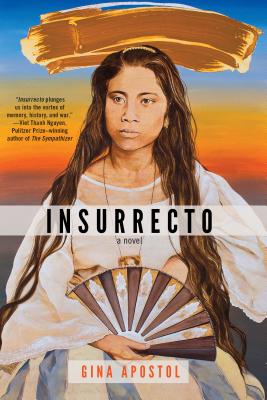Insurrecto
Gina Apostol

I found this book a difficult read in more ways than one–both literarily and as a matter of reflection on national and family history. But I found it very worthwhile and recommend reading it, especially to Americans who know little about the Philippine-American war of the early 20th century (which, of course, is virtually all of us).
I read Gina Apostol’s novel “Gun Dealers' Daughter” earlier this year and enjoyed it, although sometimes I found her complex writing style to be a challenge. “Insurrecto” is an even more complex book–I would liken it to books by Umberto Eco, whom I would have described as my favorite writer in my early 20’s, although not currently. It follows two women in the modern Duterte-era Philippines, but also contains a number of artfully nested stories–Chiara is making a movie about events in Samar during the Philippine-American war (revolutionary violence that resulted in the highest casualties among American soldiers since the Battle of Little Bighorn, followed by the indiscriminate murder of thousands of Filipino civilians); Magsalin is her translator but creates her own revision of Chiara’s script, and the story also ends up following the lives of Chiara’s parents, one of whom was a filmmaker who created a movie about Vietnam but filmed it in the Philippines…etc. The different stories and perspectives are densely layered, with chapters intentionally numbered out of order and often started without pronoun referents to deliberately blur the different stories. I found that I enjoyed the book the most if I allowed myself some confusion and was not too fastidious about making sure I was following all of the connections. I believe this was to some degree Apostol’s intent; she has spoken in interviews about how part of her goal in writing the book was to reflect her own mind’s blend of colonized and colonizer, as a Filipina living in New York. (One thing I want to note for other readers, in case it’s unclear to you as it was to me: Apostol’s character Casiana Nacionales, despite her improbable-sounding name, was a real-life Filipina revolutionary–the only woman memorialized as part of the Balangiga uprising, though little is now known about her other than her name.)
As Apostol artfully shows, the events of 1901 are far from irrelevant today. The US Army stole as war trophies the church bells of the town of Balangiga, Samar, which were displayed at a military base in Cheyenne, Wyoming until literally earlier this year. (Apostol’s postscript glossary says that the bells have not been returned, which just shows how recently events have unfolded–I believe they are currently on their way back to the Philippines.) The occupying US forces used “the water cure” as a method of torturing Filipinos, which is very similar to modern waterboarding. And, perhaps the most distressing thing I learned about (from Apostol’s glossary) was the existence of the “Order of the Carabao,” a private club of American military leaders founded during the Philippine-American War that continues to exist and meet annually to this day. The club is a symbol of imperialism and racism that I am shocked to know still exists–and more than that, has hosted the likes of Colin Powell. See this Village Voice article from 2003 for some rather stomach-turning war-mongering and hearty singing of racist songs: https://www.villagevoice.com/2003/01/...). You know something is a despicable bastion of ancien regime racism when it uses racial slurs so obscure that you have to look them up (“kakiac” for khaki-colored skin)–cf. George Allen’s use of “macaca” (monkey) in his 2006 campaign for one of Virginia’s senate seats, which he just barely lost to Jim Webb.
Aside from all that, this book also made me revisit a bit of my own family history. I learned within the last couple of years that my great-grandfather’s brother, Ben Klagge, was in the US Army and stationed in the Philippines in the early 1900s. I learned this because I found in my grandma’s attic some postcards that he had sent to my great-grandfather from the Philippines. The postcards don’t tell anything about his experience or role there–he seems to have just sent them along for the images–but at least one was stamped and postmarked from Manila in 1909. I got interested in this (since my wife’s family came from the Philippines) and ended up donating the postcards to a museum in the Philippines (Museo de La Salle) when I was there earlier this year. Since I knew the Philippine-American War happened around this time, I had looked up the dates; seeing that the war ended in 1902, I just assumed that Ben had been a grunt stationed on an army base well after the end of the conflict. But reading “Insurrecto” and doing some further research, I am much less confident in this view–the US military (and pro-American Filipino forces) continued fighting pro-independence forces in the more distant provinces all the way until 1912. So my great-grand-uncle may well have been an active participant in killing Filipinos and suppressing the movement for independence. I know we all have unpleasant things in our family trees if we look hard enough, but it is a little vertiginous to realize that only three generations separate me and Ben. And if nothing else, I certainly wish I had done more homework and gotten a little more perspective before bringing the postcards to the museum.
I try to remember that I’m not the only American who knows very little about the Philippine-American War–it’s a rather dark part of our country’s history that many would prefer kept tidily under the rug. I’m glad Apostol wrote this book, which is not only a very strong novel on its own merits, but which should also play a role in increasing awareness of this imperialist war in our collective memory.